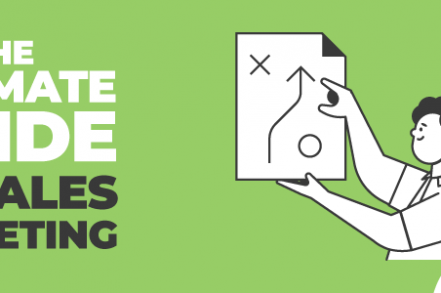When it comes to sales, there is a lot of conversation around closing. It’s the hot-button topic because it’s a clear event that has a specific resolution: making a sale.
However, there is much more to the process of selling than closing. In fact, without the right process from start to finish, you won’t set your team up to close many deals at all. This helps explain why 40% of companies failed to meet their sales revenue goals last year.
Then, when you keep in mind that 50% of your leads are simply not a good fit for your product, you can see why sales targeting is so important. With the right sales targeting, you can ensure you’re giving your presentation to someone who actually needs your product. Otherwise, you risk wasting your time and sales productivity.
So, let’s talk about what sales targeting is, and how to use it in your business. That way you can increase your sales revenues in 2024 and beyond:
What is Sales Targeting?
Sales targeting is all about identifying the best prospects — those most likely to buy your product — and crafting a sales process catered to them.
In essence, there are two parts to sales targeting: selecting the right potential customers, and finding out how to reach them most effectively and efficiently. Instead of a shotgun approach, it is a finely tuned strategy.
In the past, companies often tried to simply advertise to as many people as possible. But with more data available, it’s clear that reaching only a select few can provide more precise targeting and better sales results.
Why is Sales Targeting Important in 2024?
Companies today have more access to information and potential leads than ever before. But the risk of wasting time and resources on bad leads is also high. Therefore, sales targeting is important in 2024 for several reasons, including:
- Save Time – Productivity is an essential focus for modern sales teams. Chasing leads who aren’t qualified will keep you from potential whale clients.
- Improve Closing Ratios – You’ll be presenting to prospects who are proven to be more likely to buy, increasing closing percentages.
- Less is More – Not all clients are worth the same to your company. Spending less time on fewer, higher quality customers is a net positive.
Additional Reading: Best Chrome Extensions for Sales Professionals
5 Steps to Creating a Sales Targeting Strategy
Now let’s dive into the core strategies to bring your new sales targeting to life:
1. Identify Your Avatar
Your ideal customer persona, or avatar, gives you some objective criteria to focus on right from the start. This typically includes information such as:
- Age
- Income
- Gender
- Location
- Job title
- Industry
But what if you don’t really know this yet? There are some ways to determine what your avatar should look like:
- Current Customers – Look at your database of existing customers. Ideally, you have collected information via email, CRM, or other means. Which customer profiles align with higher sales and closing rates?
- Competition – What are others in your industry doing? Who tends to attend their events? What kind of people are they showing in their commercials or other advertising? It’s not exact, but it will give you some clues to go on.
- Surveys and Industry Data – Look to industry reports and marketing firms who release in-depth reports. They may cost you some investment to gain access, but they can be worth their weight in gold. Not to mention, they save you the time from doing it yourself.
- Test It – If you’re starting from scratch, you may simply need to test your marketing and sales funnels on differing markets. Platforms like Facebook allow you to display your marketing to particular demographics. You’ll have side-by-side comparisons of response rates and revenue attributed to different customers.
Once you’ve identified your avatar, you’re ready for the next sales targeting step:
2. Segment Based on Awareness
In the first step, we already segmented in a way. We identified a segment of the population or market that is best suited to our product or service.
But just because someone has the right avatar characteristics, doesn’t mean they are ready for sales outreach. A key part of sales targeting is ensuring that you’re communicating with prospects at the right time as well.
If you reach out too soon, someone may not have seen enough marketing to be prepared for a sales conversation, for instance. Here are three stages of awareness and how they can shape your sales strategy:
Stage 1 – Least Aware
Least aware prospects are those that have a low amount of exposure to or information about your product. Prospects at this stage of the funnel are typically not as responsive to pricing or specific product details.
Instead, your sales targeting should include a way to focus on the wants and needs of your market on a higher level.
Lead Temperature: Cold
Stage 2 – Somewhat Aware
A prospect who is somewhat aware has seen or interacted with company advertising. Alternatively, they may be aware of your company via word of mouth.
At this stage of awareness, prospects understand that they have a problem. They also know of one or two companies that can solve their problem, such as yours.
However, the prospect is still collecting information and comparing options. Trying to sell someone on the phone at this stage is typically still too early.
Lead Temperature: Warm
Stage 3 – Most Aware
The most aware prospects are those who have enough information to finally make a purchasing decision. They understand their problem, they want it solved, and they know the key differences between various products on the market.
At this stage, companies typically aim to schedule calls with sales closers. Your sales targeting methodology should be aimed at turning as many people into “most aware” prospects as possible, within your avatar’s criteria.
Lead Temperature: Hot
Additional Reading: Sales Email Tracking Guide

3. Determine Budget
Great sales organizations use sales targeting to eliminate bad leads. One sign of a bad lead is a person or company that simply doesn’t have the financial resources to purchase your product.
If your company offers financing or payment installments, then you may have more flexibility. But typically, you’ll want to qualify prospects on their budget before hopping on the phone to make the most use of your salespeople’s time.
4. Identify Decision Makers
The last thing you want is to waste time presenting your product to someone who doesn’t even have the authority to purchase it. Identifying decision makers is a crucial step in any sales targeting approach.
Whether you approach the lead online or over the phone, always ask them who else may be involved in the purchasing decision. You’ll want all decision makers in the loop from the start.
This is where the distinction between marketing and sales becomes very important. The marketing department will identify leads based on the avatar of your sales targeting strategy.
However, the sales department should limit its contact to prospects who not only fit the initial avatar but are also in the most aware stage and proven to be decision makers.
This ensures that every sales conversation is efficient — it is only conducted with the people most likely to purchase your product or service.
5. Start With “Low Hanging Fruit”
We mentioned earlier that focusing on the most aware prospects will increase your sales closing percentages. This is true when compared to cold outbound leads at low levels of awareness.
However, there are prospects that can offer even better ROI for sales targeting. This assumes you have an established brand already of course. These low hanging fruits are:
- Existing Customers – People who have already bought or used your product or service. Ideally, these are customers who have also remained active with repeat purchasing or filling out surveys. This shows brand loyalty and increases purchase likelihood.
- Referrals – Anyone who has been referred to your company by an existing customer or industry ally.
- Inbound Leads – By their nature, inbound leads have taken action and expressed interest in your offering by providing their information or clicking your advertisements.
How to Measure Success of Your Sales Targeting Strategy
To understand whether your sales targeting is successful, you need to establish baseline metrics to compare before and after, such as:
- Response Rate – How many prospects are responding to your outbound or inbound marketing, compared to the total of prospects that were reached?
- Contact to Appointment Ratio – Of the prospects that respond to your targeting outreach, how many agreed to appointments with your team?
- Appointment to Close Ratio – Is your closing ratio from your new sales targeting approach improving or decreasing?
- Average Purchase Amount and Lifetime Value – More customers are great. But at the end of the day, you want to onboard a new business that has a higher lifetime value to your company.
These are just some of the metrics you can use to gauge sales targeting success. Additional decision making frameworks will be unique to your organization and its goals.
Sales Targeting FAQ
Some common questions regarding sales targeting are:
What kind of industries should use sales targeting?
Every industry can and should use sales targeting. This is especially true if your list of potential customers is small and specific.
Is sales targeting expensive?
Like any sales or marketing activity, sales targeting has some financial and time requirements. However, once it is set up, it is much less expensive than the alternative of lower revenue numbers.
What tools can you use for sales targeting?
You can use several tools at our disposal: keyword research, paid advertising data, phone calls, emails, bought lists, and more.
How to know if sales targeting is effective?
By analyzing your sales targeting results using the metrics mentioned above, you can stay on top of your strategy to ensure it remains effective.
Wrap Up
In selling, the person you’re pitching is just as important as your product itself. You can have the best product or service in the world, but when shown to the wrong prospect it won’t shine.
That’s why having the right sales targeting approach is so important. As the world moves digital and away from face-to-face marketing, you need systemized ways to connect with and analyze your potential customers.
For this reason, Garnter predicts that cloud services will grow 21.7% to $482 billion in 2022. And in another sales report, Gartner found that when salespeople send up to three messages at the same time on different communication channels, they can improve response rates by 14%.
So make sure you know who you’re targeting first. That will allow you to reach them early and often via a multi-channel approach that’s appropriate for 2024, and beyond.
Track emails, email reminders & templates in Gmail for free
Upgrade Gmail with the features it’s missing
Add to GmailDavid Campbell
David Campbell is the editor of the Right Inbox blog. He is passionate about email productivity and getting more done in less time.




